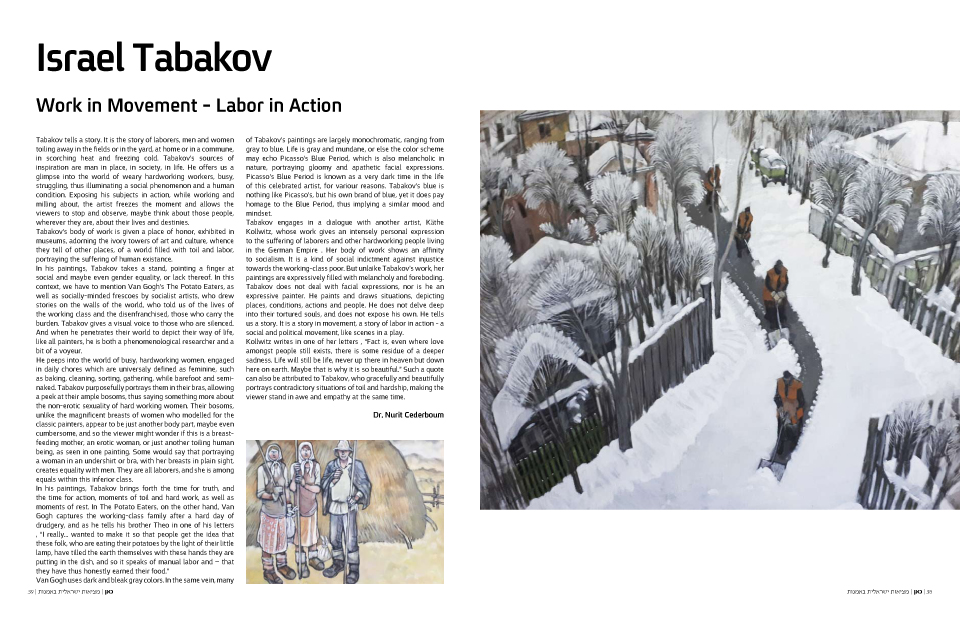
| Home Page | Editor Notices | Museums | Galleries | Publication | Donation | Contact Us |


 | |||||||||||||||
| |||||||||||||||


| |||||||||||||||
| Israel Tabakov / Work in Movement - Labor in Action |
Tabakov tells a story. It is the story of laborers, men and women toiling away in the fields or in the yard, at home or in a commune, in scorching heat and freezing cold. Tabakov’s sources of inspiration are man in place, in society, in life. He offers us a glimpse into the world of weary hardworking workers, busy, struggling, thus illuminating a social phenomenon and a human condition. Exposing his subjects in action, while working and milling about, the artist freezes the moment and allows the viewers to stop and observe, maybe think about those people, wherever they are, about their lives and destinies. Tabakov’s body of work is given a place of honor, exhibited in museums, adorning the ivory towers of art and culture, whence they tell of other places, of a world filled with toil and labor, portraying the suffering of human existance. In his paintings, Tabakov takes a stand, pointing a finger at social and maybe even gender equality, or lack thereof. In this context, we have to mention Van Gogh’s The Potato Eaters, as well as socially-minded frescoes by socialist artists, who drew stories on the walls of the world, who told us of the lives of the working class and the disenfranchised, those who carry the burden. Tabakov gives a visual voice to those who are silenced. And when he penetrates their world to depict their way of life, like all painters, he is both a phenomenological researcher and a bit of a voyeur. He peeps into the world of busy, hardworking women, engaged in daily chores which are universaly defined as feminine, such as baking, cleaning, sorting, gathering, while barefoot and semi-naked. Tabakov purposefully portrays them in their bras, allowing a peek at their ample bosoms, thus saying something more about the non-erotic sexuality of hard working women. Their bosoms, unlike the magnificent breasts of women who modelled for the classic painters, appear to be just another body part, maybe even cumbersome, and so the viewer might wonder if this is a breast-feeding mother, an erotic woman, or just another toiling human being, as seen in one painting. Some would say that portraying a woman in an undershirt or bra, with her breasts in plain sight, creates equality with men. They are all laborers, and she is among equals within this inferior class. In his paintings, Tabakov brings forth the time for truth, and the time for action, moments of toil and hard work, as well as moments of rest. In The Potato Eaters, on the other hand, Van Gogh captures the working-class family after a hard day of drudgery, and as he tells his brother Theo in one of his letters , “I really... wanted to make it so that people get the idea that these folk, who are eating their potatoes by the light of their little lamp, have tilled the earth themselves with these hands they are putting in the dish, and so it speaks of manual labor and — that they have thus honestly earned their food." Van Gogh uses dark and bleak gray colors. In the same vein, many of Tabakov’s paintings are largely monochromatic, ranging from gray to blue. Life is gray and mundane, or else the color scheme may echo Picasso’s Blue Period, which is also melancholic in nature, portraying gloomy and apathetic facial expressions. Picasso’s Blue Period is known as a very dark time in the life of this celebrated artist, for variour reasons. Tabakov’s blue is nothing like Picasso’s, but his own brand of blue, yet it does pay homage to the Blue Period, thus implying a similar mood and mindset. Tabakov engages in a dialogue with another artist, K?the Kollwitz, whose work gives an intensely personal expression to the suffering of laborers and other hardworking people living in the German Empire . Her body of work shows an affinity to socialism. It is a kind of social indictment against injustice towards the working-class poor. But unlaike Tabakov’s work, her paintings are expressively filled with melancholy and foreboding. Tabakov does not deal with facial expressions, nor is he an expressive painter. He paints and draws situations, depicting places, conditions, actions and people. He does not delve deep into their tortured souls, and does not expose his own. He tells us a story. It is a story in movement, a story of labor in action - a social and political movement, like scenes in a play. Kollwitz writes in one of her letters , “Fact is, even where love amongst people still exists, there is some residue of a deeper sadness. Life will still be life, never up there in heaven but down here on earth. Maybe that is why it is so beautiful.” Such a quote can also be attributed to Tabakov, who gracefully and beautifully portrays contradictory situations of toil and hardship, making the viewer stand in awe and empathy at the same time. Dr. Nurit Cederboum Read more  |
| all rights reserved - CAN ISRAELI ART REALITY |
| סייבורג מחשבים - בניית אתרים |